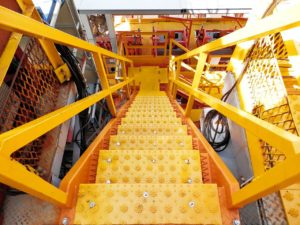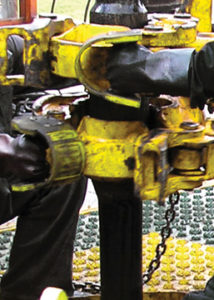The drilling industry is rife with the potential for accidents. In fact, it’s one of the most hazardous occupations around. Crush injuries, slips, falls, and fires are just a few of the top hazards that can occur on oil rigs. That’s why prevention is key, and worker safety remains paramount in the oil industry.

Safety Mats for Rig Floor and Stairs
Falls from 100 feet or more are not uncommon on oil rigs, and that is why fall protection equipment is so important, especially for derrick hands, who work on small, elevated platforms. Body harnesses, positioning lanyards, anchors, and connectors are a few of the crucial pieces of equipment that can protect workers. Falling objects are another danger. Hard hats should be worn at all times, and tools should be attached to the worker’s belts or the platform structure.

Tong Handle Guard, protects the entire hand
Hand injuries make up nearly half of all incidents in the oil industry. They range from the crush and pinching injuries to abrasions and lacerations. Crush accidents, particularly involving the hands, are an especially serious risk when handling objects such as drill pipe tongs and power tongs.
Making sure everyone is aware of potential danger spots is another key component of oil rig safety. Potentially hazardous areas—such as confined space entries, moving machinery, high-pressure valves, and flammable material storage areas—should be visibly labeled. It’s also important for personnel to know where eye wash stations and first-aid kits are in case of an emergency. Communication is crucial when it comes to avoiding confusion and accidents on a rig.
Fires are another danger. When flammable gases meet an open flame, the result can be deadly. Preventing a fire from developing requires implementing certain standards, including making sure that spark arrestors are available near any spark-producing equipment, such as internal combustion engines. This equipment should also be located far enough away from any flammable gases that the dangers of an explosion are acceptably low. Outfitting workers with flame-resistant clothing is another important precaution.
It’s important to keep in mind that human error, such as fatigue and exhaustion, can also contribute to accidents. Creating a space of open communication, and making sure workers are able to recognize their state of mind and make adjustments accordingly, is crucial when it comes to preventing accidents.




